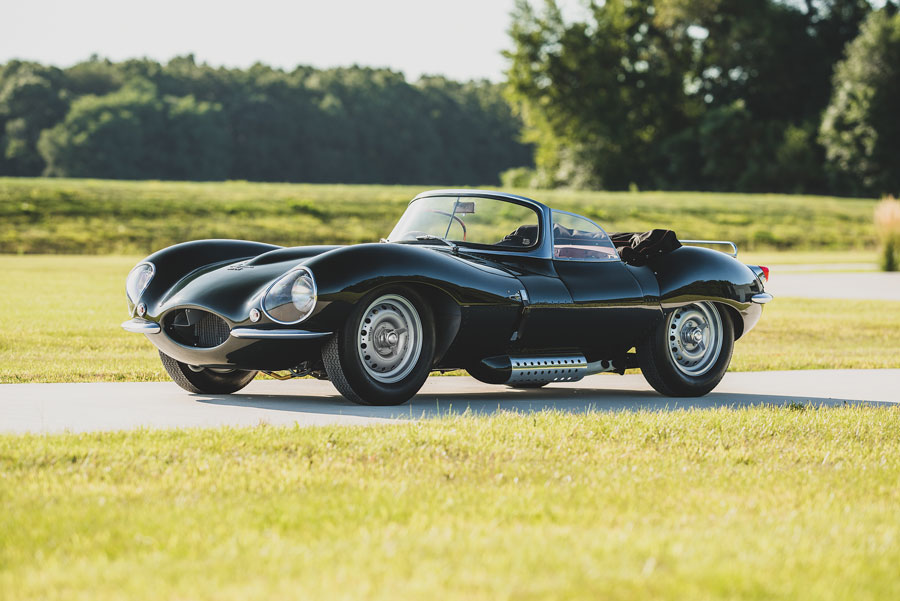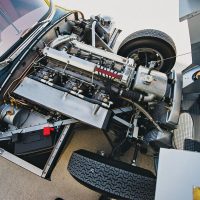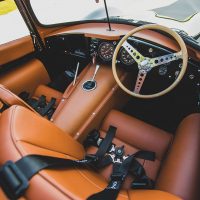There are few modern sports cars around which legends gather more thickly than the Jaguar XKSS. Following the company’s withdrawal from racing after the 1956 season, a number of both completed and incomplete D-types remained in factory stock and unsold. The decision was made to convert these cars to road-going specification, for sale to the wanting American market. Bodywork was modified, with the removal of the divider between the seats and the large tail fin, as well as the addition of a passenger’s door, a full-width windshield with chromed frame, side screens in both driver’s and passenger’s doors, chromed bumperettes and a simple folding top. Otherwise the XKSS was a D-type, barely, slightly tamed — a wolf in another wolf’s clothing.
After only 16 D-types had been completed to XKSS specification, the remaining nine chassis were destroyed in a fire that swept through Jaguar’s Browns Lane factory. Since the intention had been only to build the model until the remaining D-type stock was used up, the fire meant that the XKSS came to an end.
Because the XKSS is so fiercely sought after, in March 2016 Jaguar announced that it would complete the original intended production run of 25 cars by finally building the nine XKSS lost to the Browns Lane fire. The original run of nine XKSS produced in 2017 sold out virtually upon introduction. It speaks to the quality of these cars that, like the 16 built in 1957, they are seldom ever offered for sale by their owners. In fact, the offering of this example is believed to be the first time that one has been offered at public auction, marking an extremely rare opportunity and special occasion for a potential buyer.
SCM Analysis
Detailing
| Vehicle: | 2017 Jaguar XKSS Continuation |
| Years Produced: | 2016–17 |
| Number Produced: | 9 |
| Chassis Number Location: | Stamped in left front shock tower |
| Engine Number Location: | Rear face at front of cylinder head |
| Club Info: | Jaguar Enthusiasts’ Club, Jaguar Club of North America |
| Website: | http://www.jcna.com |
| Alternatives: | 1950–53 Jaguar C-type, 1953–55 Jaguar D-type, 1957–60 Ferrari 250 GT Spyder California |
This car, Lot 2256, sold for $1,985,000, including buyer’s premium, at RM Sotheby’s Elkhart Collection sale on October 23, 2020, in Elkhart, IN.
As the catalog said, this is the first public sale of one of the continuation Jaguars — or, for that matter, of any of these recent continuation cars. They have led to a lot of column inches, both here in SCM (see “Collecting Thoughts: Factory Fakes and Why They Matter,” September 2020) and elsewhere. Yet I don’t think continuations have affected the value of the originals, other than to perhaps enhance them by shining a spotlight on a model’s rarity.
This car was made by Jaguar, which gave it a real chassis number. It is doubtful, however, whether any of the owners of the 16 originals will see it as the real thing. Yet, with total production now at 25, the XKSS is still rarer than a Ferrari 250 GTO.
Also in this sale were two more continuation Jaguars. There was a new Lightweight E-type, one of a run of seven cars built starting in 2014, just before the nine new XKSSs. That car sold for $1.7m. Also, one of the 25 new D-types made most recently, which sold for $1,325,000. (By comparison, the record auction price for an original D-type is near $22m.) Each of these continuation cars, like the XKSS, cost around £1m new — that’s about $1.3m–$1.5m depending on exchange rates, which have fluctuated quite a bit in the past five years.
An original XKSS is currently valued at about £8m ($10m), while a period-built D-type with less-than-stellar provenance and maybe a few gaps in its history could probably be bought for around £4m ($5m) today, with genuine C-types selling for a bit less.
New Old Stock
In the glare of such fierce values, we can lose sight of the fact that in period, the XKSS was simply a way for Jaguar to shift its stock of obsolete D-types. There’s nothing so “last year” as an old racing car, so it’s ironic that these have turned into some of the most collectible (and valuable) cars in the world. Steve McQueen owning one didn’t hurt. He loved his XKSS so much that he bought it back in 1977, after having sold it in ’69, and it remained with him until his death.
This car was sold on a bill of sale, which presumably means it has never been registered. In Europe, these continuations are not road-legal as they don’t pass modern safety regs. So unless the new owner goes through a lengthy and expensive Single Vehicle Approval process (see “Collecting Thoughts,” December 2020), they cannot be registered. This is unlike, say, a copy of a Ferrari 250 GTO made from a GTE. As it retains the original car’s identity, the officials are (usually) none the wiser. It’s still a “1963 Ferrari 250GT,” Robert’s yer muvver’s bruvver and everyone’s happy as Larry.
Telling the difference
This is indisputably a new car. Even a non-expert should be able to tell the difference from an original because these have plusher interior trim and bigger seats than the originals. With only 51 miles on the clock, there’s not much to say about its condition, as it is almost unused. It is curious to see the rev counter tell-tale was already past its 5,900-rpm redline. Let’s assume (hope) that the engine was thoroughly bench-tested before being put in the car. Other detail changes from original spec include a modern alternator and fuel cell. The artificially aged chassis plate, the only bit of “patina” on the car, just looks silly when the rest of it is mint.
What one of these costs new is about twice what a perfect tool-room copy of the same would set you back. Any one of a number of specialists can provide such a car, with the advantage that those can probably be driven on the road. This is usually by assuming the identity of the E-type, S-type or Mk 2 that most of the bits came from.
Track toy?
It is also possible to get approval to race in vintage events via gaining a Historic Technical Passport. This is an FIA document that states that the car is bolt-for-bolt the same as one that came out of the factory in the 1950s. Used FIA/HTP C-type copies sell in the £200–£250k range. Jaguar, however, has recently insisted that sellers do not describe these cars as “Jaguars.” One has to wonder whether that’s where it will focus its continuation skills next.
All three of the continuation cars in the Elkhart Collection sale could get HTP papers, but it would be an expensive way to get on track when you could simply build a new racer more cheaply. So our subject car’s value, such as it is, is indexed to the fact that it’s a factory-sanctioned production. Depending on how you split the semantics, it can legitimately be described as “the real thing,” even if it isn’t, really.
A couple of questions to ponder: Given that you could have a perfect copy built for around $500k, does having a real chassis number confer this much extra value, boosting it by a factor of three or four? And if it does, demand and supply being what it is, should not these cars have sold for two or three times their price when new? This market-has-spoken moment clearly didn’t happen, as none of the continuation Jaguars in this sale improved much on their list prices. We do, however, now have a benchmark for factory continuation cars. Or a line in the sand, at least. ♦
(Introductory description courtesy of RM Sotheby’s.)





